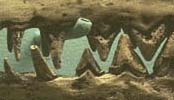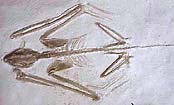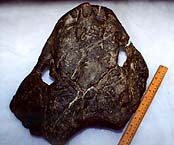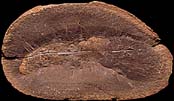Mystery Fossil Archives#1–9 | #10–18 | #19–27 | #28–36 | #37–45 | #46–54
Click on the image for a closer look at each Mystery Fossil. Can you guess
them all correctly? |
|
#10—May, 2001 |
|
 |
So you’ve identified these as teeth. That’s a start. Now what could they belong to? Collected from rocks of Eocene age in Pakistan, this fossil skull is from a critter that is the earliest known of its kind. Do you know what it is?
|
#11—June/July, 2001 |
|
 |
Could this fossil be a plant? It appears to have a stalk or stem. But it used that stalk to anchor itself to the sea floor, not to hold leaves up to the sun. There aren’t many living today. Do you know what it is?
|
#12—August, 2001 |
|
 |
This fossil skeleton appears to have long arm bones. Could it be a pterosaur of some kind? Nope. Fossils of this kind of critter are quite rare and don’t appear until after the Cretaceous-Tertiary extinction episode. Do you know what it is?
|
#13—September, 2001 |
|
 |
If you think this oddly-shaped chunk of bone might be a skull, you’re right. It’s a bit incomplete and deformed, but even in life this turtle relative probably looked very strange. Do you know what it is?
|
#14—October, 2001 |
|
 |
Could it be fossil dandelions?! Not even close. Only one genus of this type of organism exists today but they were once very common back in the Carboniferous (286 to 360 million years ago). Do you know what it is?
|
#15—November, 2001 |
|
 |
Most fossils of these colonial marine animals are incomplete and resemble short sections of hacksaw blade, but this is a fairly complete specimen. Paleontologists were mystified as to the nature of these creatures for a long time. Do you know what these are?
|
#16—December, 2001 |
|
 |
Relatives of this bizarre-looking creature still exist today but fossils of these marine animals are extremely rare and are found only in Devonian rocks of western Germany. Do you know what it is?
|
#17—January, 2002 |
|
 |
Better click on this image to see an enlarged view. Don’t let the lack of legs on this skeleton fool you—this is not a snake. It’s a legless member of a class of animals that arose in the Upper Carboniferous and whose descendants are still with us today. Do you know what it is?
|
#18—February, 2002 |
|
 |
This may look like an ordinary rock but that elongate impression in the middle of it is actually the rarely preserved body fossil of a marine organism whose skeleton, made up of microscopic spicules (a big clue!) is all that is usually preserved. Do you know what it is?
|
|
#1–9 | #10–18 | #19–27 | #28–36 | #37–45 | #46–54 Home | What's new | About UCMP | History of life | Collections | Other resources |
|
| |
|